Contemporary Business Issues Facing IKEA: A Detailed Analysis
VerifiedAdded on 2023/01/17
|10
|2764
|42
Essay
AI Summary
This essay examines the contemporary business issues faced by IKEA, a multinational furniture company. The introduction provides an overview of IKEA, its global presence, and its success factors, while highlighting the challenges it faces in a dynamic business environment. The body of the essay delves into specific issues, such as meeting diverse consumer expectations across different national markets (e.g., the U.S. and Japan) and adapting to cross-cultural differences. It uses cross-cultural theories, particularly Hofstede's cultural dimensions, to analyze these challenges, focusing on power distance, individualism versus collectivism, and uncertainty avoidance within IKEA's organizational culture. The essay concludes with recommendations for IKEA to embrace diversity, promote open communication, and conduct market research to better understand and meet consumer needs in different regions. The essay underscores the importance of cultural understanding and adaptation for successful international business expansion.
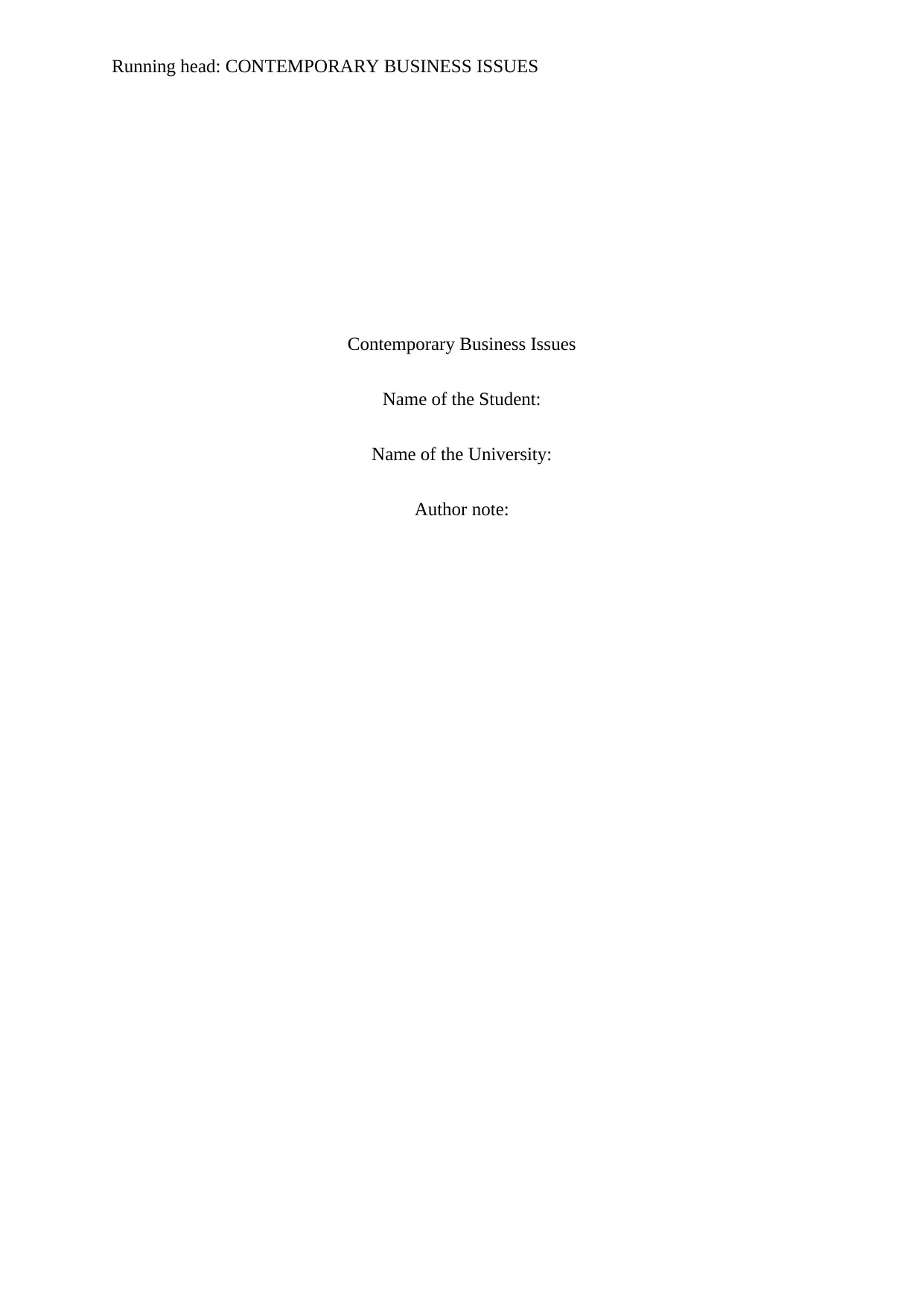
Running head: CONTEMPORARY BUSINESS ISSUES
Contemporary Business Issues
Name of the Student:
Name of the University:
Author note:
Contemporary Business Issues
Name of the Student:
Name of the University:
Author note:
Paraphrase This Document
Need a fresh take? Get an instant paraphrase of this document with our AI Paraphraser
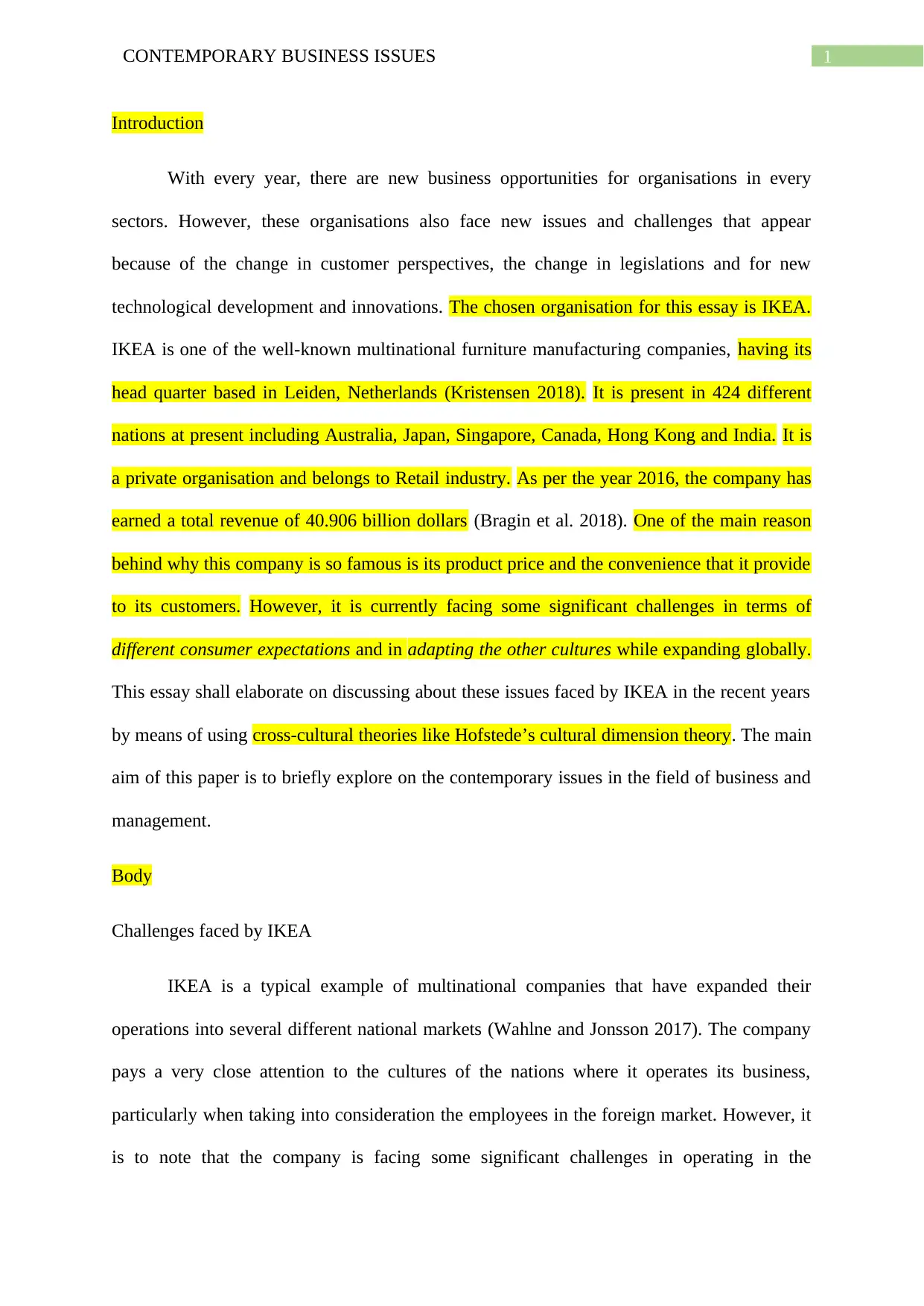
1CONTEMPORARY BUSINESS ISSUES
Introduction
With every year, there are new business opportunities for organisations in every
sectors. However, these organisations also face new issues and challenges that appear
because of the change in customer perspectives, the change in legislations and for new
technological development and innovations. The chosen organisation for this essay is IKEA.
IKEA is one of the well-known multinational furniture manufacturing companies, having its
head quarter based in Leiden, Netherlands (Kristensen 2018). It is present in 424 different
nations at present including Australia, Japan, Singapore, Canada, Hong Kong and India. It is
a private organisation and belongs to Retail industry. As per the year 2016, the company has
earned a total revenue of 40.906 billion dollars (Bragin et al. 2018). One of the main reason
behind why this company is so famous is its product price and the convenience that it provide
to its customers. However, it is currently facing some significant challenges in terms of
different consumer expectations and in adapting the other cultures while expanding globally.
This essay shall elaborate on discussing about these issues faced by IKEA in the recent years
by means of using cross-cultural theories like Hofstede’s cultural dimension theory. The main
aim of this paper is to briefly explore on the contemporary issues in the field of business and
management.
Body
Challenges faced by IKEA
IKEA is a typical example of multinational companies that have expanded their
operations into several different national markets (Wahlne and Jonsson 2017). The company
pays a very close attention to the cultures of the nations where it operates its business,
particularly when taking into consideration the employees in the foreign market. However, it
is to note that the company is facing some significant challenges in operating in the
Introduction
With every year, there are new business opportunities for organisations in every
sectors. However, these organisations also face new issues and challenges that appear
because of the change in customer perspectives, the change in legislations and for new
technological development and innovations. The chosen organisation for this essay is IKEA.
IKEA is one of the well-known multinational furniture manufacturing companies, having its
head quarter based in Leiden, Netherlands (Kristensen 2018). It is present in 424 different
nations at present including Australia, Japan, Singapore, Canada, Hong Kong and India. It is
a private organisation and belongs to Retail industry. As per the year 2016, the company has
earned a total revenue of 40.906 billion dollars (Bragin et al. 2018). One of the main reason
behind why this company is so famous is its product price and the convenience that it provide
to its customers. However, it is currently facing some significant challenges in terms of
different consumer expectations and in adapting the other cultures while expanding globally.
This essay shall elaborate on discussing about these issues faced by IKEA in the recent years
by means of using cross-cultural theories like Hofstede’s cultural dimension theory. The main
aim of this paper is to briefly explore on the contemporary issues in the field of business and
management.
Body
Challenges faced by IKEA
IKEA is a typical example of multinational companies that have expanded their
operations into several different national markets (Wahlne and Jonsson 2017). The company
pays a very close attention to the cultures of the nations where it operates its business,
particularly when taking into consideration the employees in the foreign market. However, it
is to note that the company is facing some significant challenges in operating in the
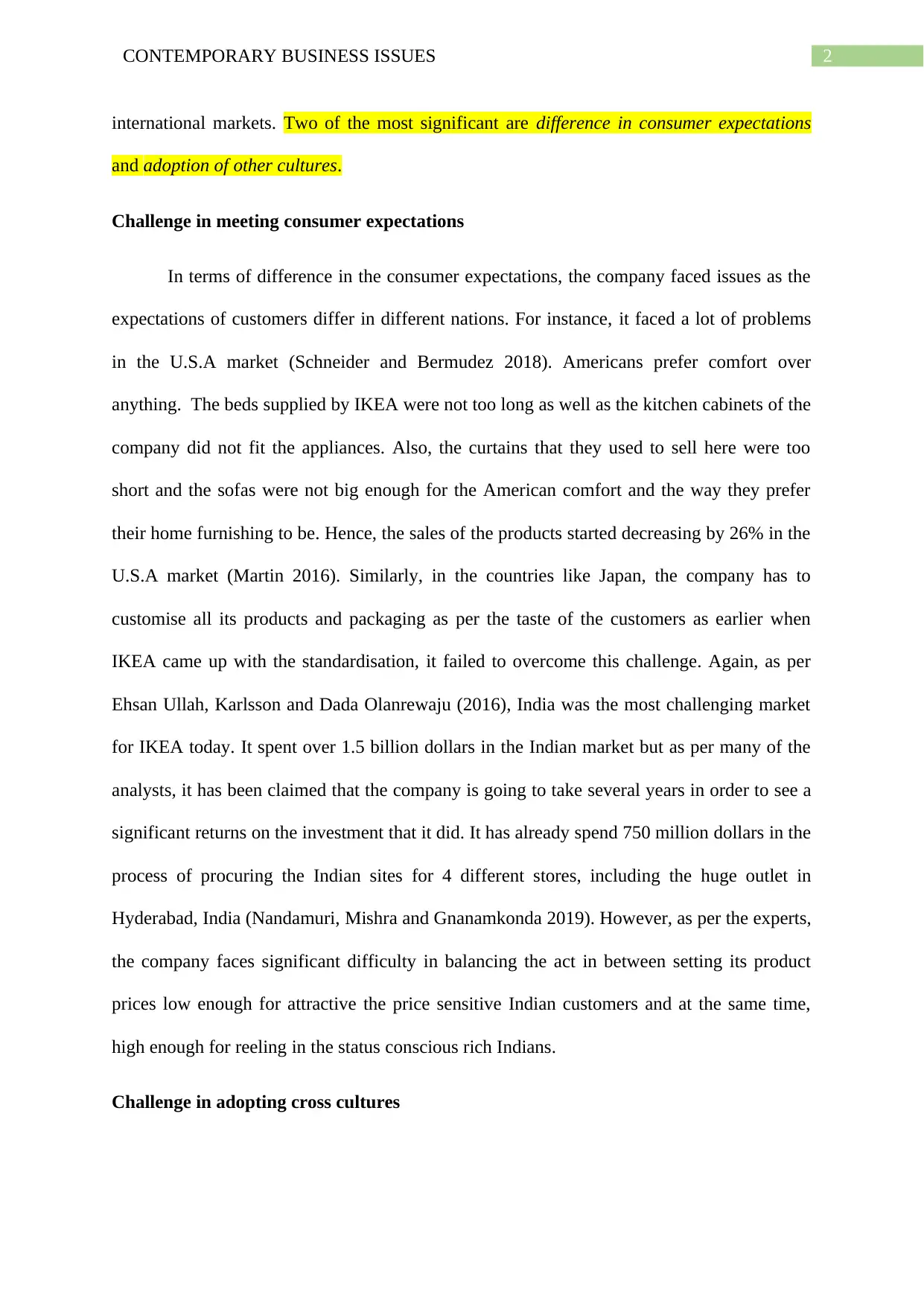
2CONTEMPORARY BUSINESS ISSUES
international markets. Two of the most significant are difference in consumer expectations
and adoption of other cultures.
Challenge in meeting consumer expectations
In terms of difference in the consumer expectations, the company faced issues as the
expectations of customers differ in different nations. For instance, it faced a lot of problems
in the U.S.A market (Schneider and Bermudez 2018). Americans prefer comfort over
anything. The beds supplied by IKEA were not too long as well as the kitchen cabinets of the
company did not fit the appliances. Also, the curtains that they used to sell here were too
short and the sofas were not big enough for the American comfort and the way they prefer
their home furnishing to be. Hence, the sales of the products started decreasing by 26% in the
U.S.A market (Martin 2016). Similarly, in the countries like Japan, the company has to
customise all its products and packaging as per the taste of the customers as earlier when
IKEA came up with the standardisation, it failed to overcome this challenge. Again, as per
Ehsan Ullah, Karlsson and Dada Olanrewaju (2016), India was the most challenging market
for IKEA today. It spent over 1.5 billion dollars in the Indian market but as per many of the
analysts, it has been claimed that the company is going to take several years in order to see a
significant returns on the investment that it did. It has already spend 750 million dollars in the
process of procuring the Indian sites for 4 different stores, including the huge outlet in
Hyderabad, India (Nandamuri, Mishra and Gnanamkonda 2019). However, as per the experts,
the company faces significant difficulty in balancing the act in between setting its product
prices low enough for attractive the price sensitive Indian customers and at the same time,
high enough for reeling in the status conscious rich Indians.
Challenge in adopting cross cultures
international markets. Two of the most significant are difference in consumer expectations
and adoption of other cultures.
Challenge in meeting consumer expectations
In terms of difference in the consumer expectations, the company faced issues as the
expectations of customers differ in different nations. For instance, it faced a lot of problems
in the U.S.A market (Schneider and Bermudez 2018). Americans prefer comfort over
anything. The beds supplied by IKEA were not too long as well as the kitchen cabinets of the
company did not fit the appliances. Also, the curtains that they used to sell here were too
short and the sofas were not big enough for the American comfort and the way they prefer
their home furnishing to be. Hence, the sales of the products started decreasing by 26% in the
U.S.A market (Martin 2016). Similarly, in the countries like Japan, the company has to
customise all its products and packaging as per the taste of the customers as earlier when
IKEA came up with the standardisation, it failed to overcome this challenge. Again, as per
Ehsan Ullah, Karlsson and Dada Olanrewaju (2016), India was the most challenging market
for IKEA today. It spent over 1.5 billion dollars in the Indian market but as per many of the
analysts, it has been claimed that the company is going to take several years in order to see a
significant returns on the investment that it did. It has already spend 750 million dollars in the
process of procuring the Indian sites for 4 different stores, including the huge outlet in
Hyderabad, India (Nandamuri, Mishra and Gnanamkonda 2019). However, as per the experts,
the company faces significant difficulty in balancing the act in between setting its product
prices low enough for attractive the price sensitive Indian customers and at the same time,
high enough for reeling in the status conscious rich Indians.
Challenge in adopting cross cultures
⊘ This is a preview!⊘
Do you want full access?
Subscribe today to unlock all pages.

Trusted by 1+ million students worldwide
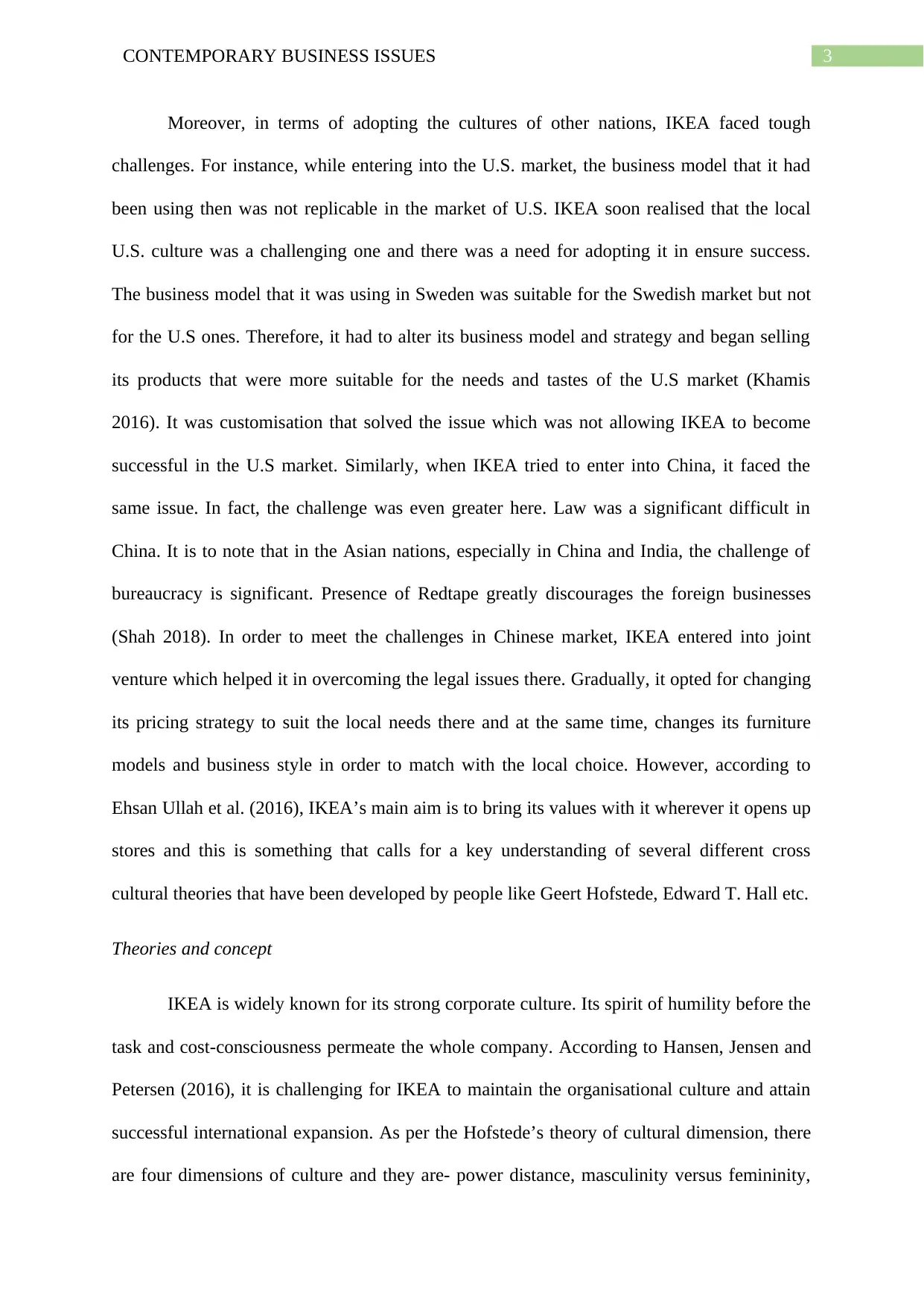
3CONTEMPORARY BUSINESS ISSUES
Moreover, in terms of adopting the cultures of other nations, IKEA faced tough
challenges. For instance, while entering into the U.S. market, the business model that it had
been using then was not replicable in the market of U.S. IKEA soon realised that the local
U.S. culture was a challenging one and there was a need for adopting it in ensure success.
The business model that it was using in Sweden was suitable for the Swedish market but not
for the U.S ones. Therefore, it had to alter its business model and strategy and began selling
its products that were more suitable for the needs and tastes of the U.S market (Khamis
2016). It was customisation that solved the issue which was not allowing IKEA to become
successful in the U.S market. Similarly, when IKEA tried to enter into China, it faced the
same issue. In fact, the challenge was even greater here. Law was a significant difficult in
China. It is to note that in the Asian nations, especially in China and India, the challenge of
bureaucracy is significant. Presence of Redtape greatly discourages the foreign businesses
(Shah 2018). In order to meet the challenges in Chinese market, IKEA entered into joint
venture which helped it in overcoming the legal issues there. Gradually, it opted for changing
its pricing strategy to suit the local needs there and at the same time, changes its furniture
models and business style in order to match with the local choice. However, according to
Ehsan Ullah et al. (2016), IKEA’s main aim is to bring its values with it wherever it opens up
stores and this is something that calls for a key understanding of several different cross
cultural theories that have been developed by people like Geert Hofstede, Edward T. Hall etc.
Theories and concept
IKEA is widely known for its strong corporate culture. Its spirit of humility before the
task and cost-consciousness permeate the whole company. According to Hansen, Jensen and
Petersen (2016), it is challenging for IKEA to maintain the organisational culture and attain
successful international expansion. As per the Hofstede’s theory of cultural dimension, there
are four dimensions of culture and they are- power distance, masculinity versus femininity,
Moreover, in terms of adopting the cultures of other nations, IKEA faced tough
challenges. For instance, while entering into the U.S. market, the business model that it had
been using then was not replicable in the market of U.S. IKEA soon realised that the local
U.S. culture was a challenging one and there was a need for adopting it in ensure success.
The business model that it was using in Sweden was suitable for the Swedish market but not
for the U.S ones. Therefore, it had to alter its business model and strategy and began selling
its products that were more suitable for the needs and tastes of the U.S market (Khamis
2016). It was customisation that solved the issue which was not allowing IKEA to become
successful in the U.S market. Similarly, when IKEA tried to enter into China, it faced the
same issue. In fact, the challenge was even greater here. Law was a significant difficult in
China. It is to note that in the Asian nations, especially in China and India, the challenge of
bureaucracy is significant. Presence of Redtape greatly discourages the foreign businesses
(Shah 2018). In order to meet the challenges in Chinese market, IKEA entered into joint
venture which helped it in overcoming the legal issues there. Gradually, it opted for changing
its pricing strategy to suit the local needs there and at the same time, changes its furniture
models and business style in order to match with the local choice. However, according to
Ehsan Ullah et al. (2016), IKEA’s main aim is to bring its values with it wherever it opens up
stores and this is something that calls for a key understanding of several different cross
cultural theories that have been developed by people like Geert Hofstede, Edward T. Hall etc.
Theories and concept
IKEA is widely known for its strong corporate culture. Its spirit of humility before the
task and cost-consciousness permeate the whole company. According to Hansen, Jensen and
Petersen (2016), it is challenging for IKEA to maintain the organisational culture and attain
successful international expansion. As per the Hofstede’s theory of cultural dimension, there
are four dimensions of culture and they are- power distance, masculinity versus femininity,
Paraphrase This Document
Need a fresh take? Get an instant paraphrase of this document with our AI Paraphraser

4CONTEMPORARY BUSINESS ISSUES
individualism versus collectivism and uncertainty avoidance (Mazanec et al. 2015). Different
nations and companies are analysed by means of questionnaires and are then ranked with
certain scores that are later determined as medium, low and high or any variation in the
between. Power distance refers to the notion of how a particular society deals with inequality.
It is the level of acceptance by a society that is based on unequal distribution of power in the
organisations (Beugelsdijk, Kostova and Roth 2017). It is to note that the companies having
high power distance cultures, the employees there acknowledge the authority of their bosses
and at the same time, follow a chain of command. Uncertainty avoidance on the other hand
refers to the extent to which the people in an organisation or nation feel threatened by the
ambiguous situations present. Individualism on the other hand refers to the tendency of the
people to fend for oneself and their family. In the companies or countries where
individualism is valued, individual achievement and initiative are highly valued (Beugelsdijk
and Welzel 2018). Also, there are countries and companies who value collectivism (Huang
and Crotts 2019). This means, doing work and achieving goal by working collectively.
Furthermore, masculinity refers to the level to which materialism and assertiveness is valued.
It is to note that in the highly masculine societies, there is a constant conflict and stress in
between the family roles and jobs.
As per Al-Sarayrah et al. (2016), in order to have a valid finding, one need to have a
constant and continuous organisational culture and then should study the culture of other
nations. On the basis of Hofstede’s four dimensions theory, the organisational culture of
IKEA can be described as a small power distance. The company has comparatively flat
organisation where the hierarchy is hardly visible. The authority in company comes from
personality and knowledge and not from the status and title. As per Thi, Trang and Latt
(2017), the informal style of clothing that exists among the employees of IKEA is another
example of low power distance. The employees and the organisational managers at IKEA
individualism versus collectivism and uncertainty avoidance (Mazanec et al. 2015). Different
nations and companies are analysed by means of questionnaires and are then ranked with
certain scores that are later determined as medium, low and high or any variation in the
between. Power distance refers to the notion of how a particular society deals with inequality.
It is the level of acceptance by a society that is based on unequal distribution of power in the
organisations (Beugelsdijk, Kostova and Roth 2017). It is to note that the companies having
high power distance cultures, the employees there acknowledge the authority of their bosses
and at the same time, follow a chain of command. Uncertainty avoidance on the other hand
refers to the extent to which the people in an organisation or nation feel threatened by the
ambiguous situations present. Individualism on the other hand refers to the tendency of the
people to fend for oneself and their family. In the companies or countries where
individualism is valued, individual achievement and initiative are highly valued (Beugelsdijk
and Welzel 2018). Also, there are countries and companies who value collectivism (Huang
and Crotts 2019). This means, doing work and achieving goal by working collectively.
Furthermore, masculinity refers to the level to which materialism and assertiveness is valued.
It is to note that in the highly masculine societies, there is a constant conflict and stress in
between the family roles and jobs.
As per Al-Sarayrah et al. (2016), in order to have a valid finding, one need to have a
constant and continuous organisational culture and then should study the culture of other
nations. On the basis of Hofstede’s four dimensions theory, the organisational culture of
IKEA can be described as a small power distance. The company has comparatively flat
organisation where the hierarchy is hardly visible. The authority in company comes from
personality and knowledge and not from the status and title. As per Thi, Trang and Latt
(2017), the informal style of clothing that exists among the employees of IKEA is another
example of low power distance. The employees and the organisational managers at IKEA
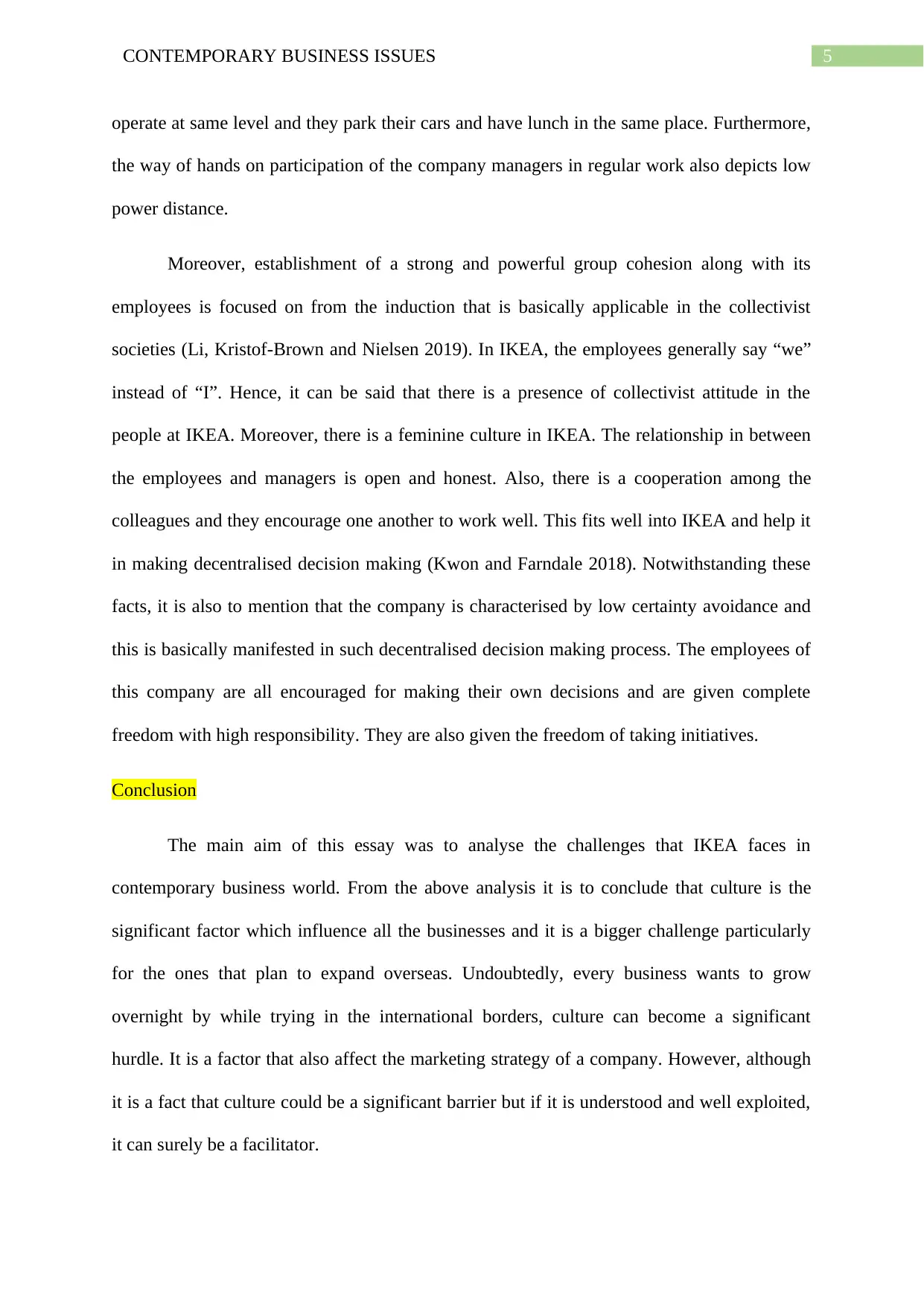
5CONTEMPORARY BUSINESS ISSUES
operate at same level and they park their cars and have lunch in the same place. Furthermore,
the way of hands on participation of the company managers in regular work also depicts low
power distance.
Moreover, establishment of a strong and powerful group cohesion along with its
employees is focused on from the induction that is basically applicable in the collectivist
societies (Li, Kristof-Brown and Nielsen 2019). In IKEA, the employees generally say “we”
instead of “I”. Hence, it can be said that there is a presence of collectivist attitude in the
people at IKEA. Moreover, there is a feminine culture in IKEA. The relationship in between
the employees and managers is open and honest. Also, there is a cooperation among the
colleagues and they encourage one another to work well. This fits well into IKEA and help it
in making decentralised decision making (Kwon and Farndale 2018). Notwithstanding these
facts, it is also to mention that the company is characterised by low certainty avoidance and
this is basically manifested in such decentralised decision making process. The employees of
this company are all encouraged for making their own decisions and are given complete
freedom with high responsibility. They are also given the freedom of taking initiatives.
Conclusion
The main aim of this essay was to analyse the challenges that IKEA faces in
contemporary business world. From the above analysis it is to conclude that culture is the
significant factor which influence all the businesses and it is a bigger challenge particularly
for the ones that plan to expand overseas. Undoubtedly, every business wants to grow
overnight by while trying in the international borders, culture can become a significant
hurdle. It is a factor that also affect the marketing strategy of a company. However, although
it is a fact that culture could be a significant barrier but if it is understood and well exploited,
it can surely be a facilitator.
operate at same level and they park their cars and have lunch in the same place. Furthermore,
the way of hands on participation of the company managers in regular work also depicts low
power distance.
Moreover, establishment of a strong and powerful group cohesion along with its
employees is focused on from the induction that is basically applicable in the collectivist
societies (Li, Kristof-Brown and Nielsen 2019). In IKEA, the employees generally say “we”
instead of “I”. Hence, it can be said that there is a presence of collectivist attitude in the
people at IKEA. Moreover, there is a feminine culture in IKEA. The relationship in between
the employees and managers is open and honest. Also, there is a cooperation among the
colleagues and they encourage one another to work well. This fits well into IKEA and help it
in making decentralised decision making (Kwon and Farndale 2018). Notwithstanding these
facts, it is also to mention that the company is characterised by low certainty avoidance and
this is basically manifested in such decentralised decision making process. The employees of
this company are all encouraged for making their own decisions and are given complete
freedom with high responsibility. They are also given the freedom of taking initiatives.
Conclusion
The main aim of this essay was to analyse the challenges that IKEA faces in
contemporary business world. From the above analysis it is to conclude that culture is the
significant factor which influence all the businesses and it is a bigger challenge particularly
for the ones that plan to expand overseas. Undoubtedly, every business wants to grow
overnight by while trying in the international borders, culture can become a significant
hurdle. It is a factor that also affect the marketing strategy of a company. However, although
it is a fact that culture could be a significant barrier but if it is understood and well exploited,
it can surely be a facilitator.
⊘ This is a preview!⊘
Do you want full access?
Subscribe today to unlock all pages.

Trusted by 1+ million students worldwide

6CONTEMPORARY BUSINESS ISSUES
Recommendations
IKEA needs to embrace diversity and must work towards adopting the cultures of the
nations where it seeks for expanding its business in order to ensure business success. It
should hire diverse workers and it is obvious that diverse workforce will present challenges
for the company in terms of customers, region and communication but IKEA should just
accept those differences and completely embrace them over its entire business. It should
implement diversity training programs throughput its company. Secondly, it should promote
open communication in the workplace as it is something that will determine the success and
failure of the business, particularly in the international market. Thirdly, in order to overcome
the problem of difference in consumer demands, IKEA should conduct surveys on regular
intervals where it can take feedbacks from its customers, identify their needs and expectations
and make a segmentation from those analysis. Instead of focusing on individual customers,
IKEA should divide them in different target segments so that it could easily detect their
expectations and work on it in international borders.
Recommendations
IKEA needs to embrace diversity and must work towards adopting the cultures of the
nations where it seeks for expanding its business in order to ensure business success. It
should hire diverse workers and it is obvious that diverse workforce will present challenges
for the company in terms of customers, region and communication but IKEA should just
accept those differences and completely embrace them over its entire business. It should
implement diversity training programs throughput its company. Secondly, it should promote
open communication in the workplace as it is something that will determine the success and
failure of the business, particularly in the international market. Thirdly, in order to overcome
the problem of difference in consumer demands, IKEA should conduct surveys on regular
intervals where it can take feedbacks from its customers, identify their needs and expectations
and make a segmentation from those analysis. Instead of focusing on individual customers,
IKEA should divide them in different target segments so that it could easily detect their
expectations and work on it in international borders.
Paraphrase This Document
Need a fresh take? Get an instant paraphrase of this document with our AI Paraphraser

7CONTEMPORARY BUSINESS ISSUES
References:
Al-Sarayrah, S., Tarhini, A., Obeidat, B.Y., Al-Salti, Z. and Kattoua, T., 2016. The effect of
culture on strategic human resource management practices: A theoretical
perspective. International Journal of Business Management and Economic Research, 7(4),
pp.704-716.
Beugelsdijk, S. and Welzel, C., 2018. Dimensions and dynamics of national culture:
Synthesizing Hofstede with Inglehart. Journal of Cross-Cultural Psychology, 49(10),
pp.1469-1505.
Beugelsdijk, S., Kostova, T. and Roth, K., 2017. An overview of Hofstede-inspired country-
level culture research in international business since 2006. Journal of International Business
Studies, 48(1), pp.30-47.
Bragin, L.A., Ivanov, G.G., Mayorova, A.N., Mayorova, E.A. and Nikishin, A.F., 2018.
Environmental Performance of Retail Trade Companies in Russia. Journal of Environmental
Management & Tourism, 9(1 (25)), pp.175-180.
Ehsan Ullah, E., Karlsson, B. and Dada Olanrewaju, D., 2016. Foreign Market Entry
Srategies.: A Case study of IKEA entering Indian Market.
Hansen, M.W., Jensen, P.D.Ø. and Petersen, B., 2016. 10. drivers and strategies of
international service firms in emerging markets. Handbook of Contemporary Research on
Emerging Markets, p.223.
References:
Al-Sarayrah, S., Tarhini, A., Obeidat, B.Y., Al-Salti, Z. and Kattoua, T., 2016. The effect of
culture on strategic human resource management practices: A theoretical
perspective. International Journal of Business Management and Economic Research, 7(4),
pp.704-716.
Beugelsdijk, S. and Welzel, C., 2018. Dimensions and dynamics of national culture:
Synthesizing Hofstede with Inglehart. Journal of Cross-Cultural Psychology, 49(10),
pp.1469-1505.
Beugelsdijk, S., Kostova, T. and Roth, K., 2017. An overview of Hofstede-inspired country-
level culture research in international business since 2006. Journal of International Business
Studies, 48(1), pp.30-47.
Bragin, L.A., Ivanov, G.G., Mayorova, A.N., Mayorova, E.A. and Nikishin, A.F., 2018.
Environmental Performance of Retail Trade Companies in Russia. Journal of Environmental
Management & Tourism, 9(1 (25)), pp.175-180.
Ehsan Ullah, E., Karlsson, B. and Dada Olanrewaju, D., 2016. Foreign Market Entry
Srategies.: A Case study of IKEA entering Indian Market.
Hansen, M.W., Jensen, P.D.Ø. and Petersen, B., 2016. 10. drivers and strategies of
international service firms in emerging markets. Handbook of Contemporary Research on
Emerging Markets, p.223.
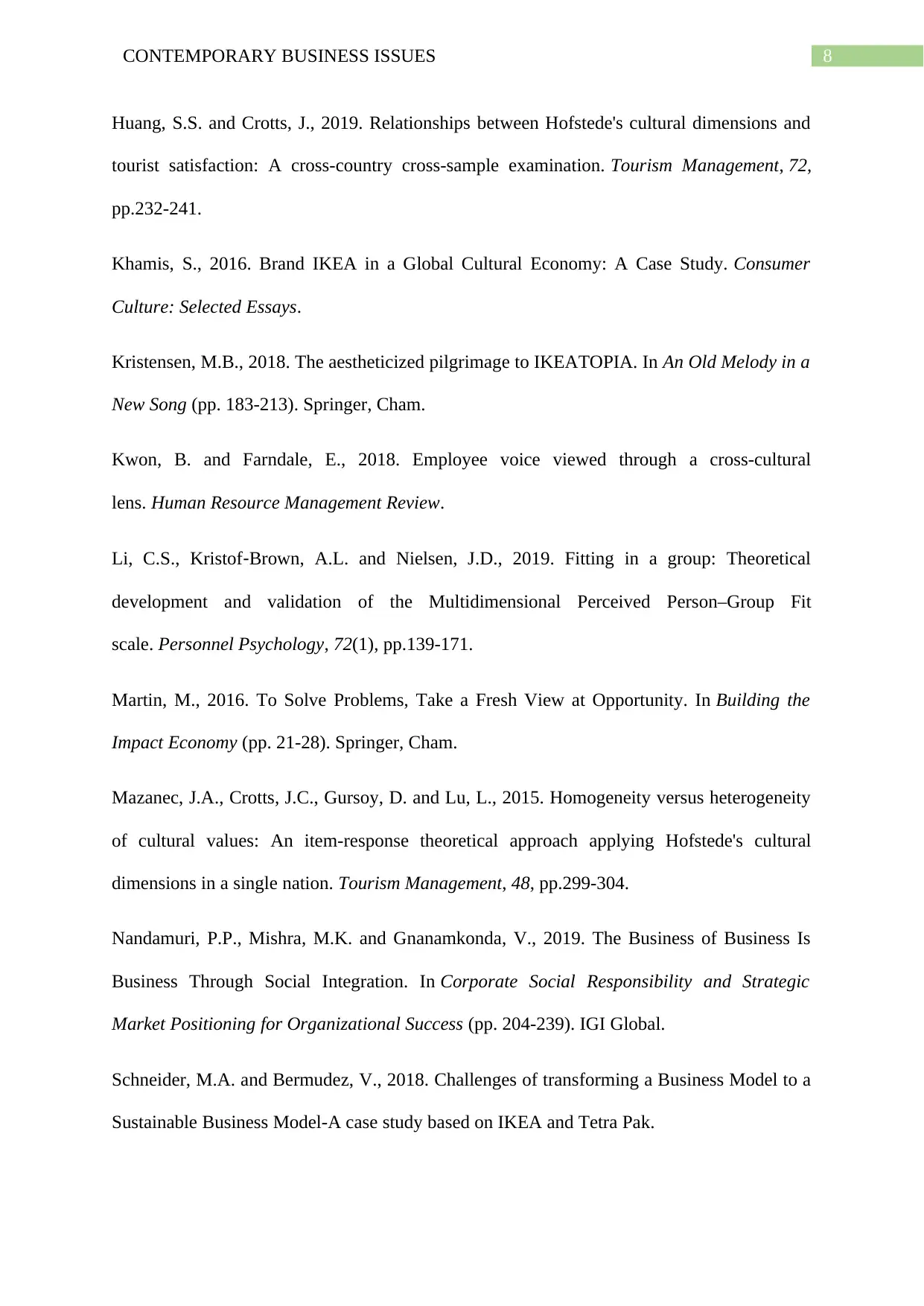
8CONTEMPORARY BUSINESS ISSUES
Huang, S.S. and Crotts, J., 2019. Relationships between Hofstede's cultural dimensions and
tourist satisfaction: A cross-country cross-sample examination. Tourism Management, 72,
pp.232-241.
Khamis, S., 2016. Brand IKEA in a Global Cultural Economy: A Case Study. Consumer
Culture: Selected Essays.
Kristensen, M.B., 2018. The aestheticized pilgrimage to IKEATOPIA. In An Old Melody in a
New Song (pp. 183-213). Springer, Cham.
Kwon, B. and Farndale, E., 2018. Employee voice viewed through a cross-cultural
lens. Human Resource Management Review.
Li, C.S., Kristof‐Brown, A.L. and Nielsen, J.D., 2019. Fitting in a group: Theoretical
development and validation of the Multidimensional Perceived Person–Group Fit
scale. Personnel Psychology, 72(1), pp.139-171.
Martin, M., 2016. To Solve Problems, Take a Fresh View at Opportunity. In Building the
Impact Economy (pp. 21-28). Springer, Cham.
Mazanec, J.A., Crotts, J.C., Gursoy, D. and Lu, L., 2015. Homogeneity versus heterogeneity
of cultural values: An item-response theoretical approach applying Hofstede's cultural
dimensions in a single nation. Tourism Management, 48, pp.299-304.
Nandamuri, P.P., Mishra, M.K. and Gnanamkonda, V., 2019. The Business of Business Is
Business Through Social Integration. In Corporate Social Responsibility and Strategic
Market Positioning for Organizational Success (pp. 204-239). IGI Global.
Schneider, M.A. and Bermudez, V., 2018. Challenges of transforming a Business Model to a
Sustainable Business Model-A case study based on IKEA and Tetra Pak.
Huang, S.S. and Crotts, J., 2019. Relationships between Hofstede's cultural dimensions and
tourist satisfaction: A cross-country cross-sample examination. Tourism Management, 72,
pp.232-241.
Khamis, S., 2016. Brand IKEA in a Global Cultural Economy: A Case Study. Consumer
Culture: Selected Essays.
Kristensen, M.B., 2018. The aestheticized pilgrimage to IKEATOPIA. In An Old Melody in a
New Song (pp. 183-213). Springer, Cham.
Kwon, B. and Farndale, E., 2018. Employee voice viewed through a cross-cultural
lens. Human Resource Management Review.
Li, C.S., Kristof‐Brown, A.L. and Nielsen, J.D., 2019. Fitting in a group: Theoretical
development and validation of the Multidimensional Perceived Person–Group Fit
scale. Personnel Psychology, 72(1), pp.139-171.
Martin, M., 2016. To Solve Problems, Take a Fresh View at Opportunity. In Building the
Impact Economy (pp. 21-28). Springer, Cham.
Mazanec, J.A., Crotts, J.C., Gursoy, D. and Lu, L., 2015. Homogeneity versus heterogeneity
of cultural values: An item-response theoretical approach applying Hofstede's cultural
dimensions in a single nation. Tourism Management, 48, pp.299-304.
Nandamuri, P.P., Mishra, M.K. and Gnanamkonda, V., 2019. The Business of Business Is
Business Through Social Integration. In Corporate Social Responsibility and Strategic
Market Positioning for Organizational Success (pp. 204-239). IGI Global.
Schneider, M.A. and Bermudez, V., 2018. Challenges of transforming a Business Model to a
Sustainable Business Model-A case study based on IKEA and Tetra Pak.
⊘ This is a preview!⊘
Do you want full access?
Subscribe today to unlock all pages.

Trusted by 1+ million students worldwide

9CONTEMPORARY BUSINESS ISSUES
Shah, M.H., 2018. Corruption and foreign direct investment: The case of South
Asia. PUTAJ-Humanities and Social Sciences, 25(1), pp.1-16.
Thi, T., Trang, T. and Latt, K.Z., 2017. Cross-Cultural Communication Challenges between
Swedish Managers and Burmese and Vietnamese Employees: How are those Communication
Challenges related to GLOBE’s Cultural Dimensions?.
Vahlne, J.E. and Jonsson, A., 2017. Ambidexterity as a dynamic capability in the
globalization of the multinational business enterprise (MBE): Case studies of AB Volvo and
IKEA. International Business Review, 26(1), pp.57-70.
Shah, M.H., 2018. Corruption and foreign direct investment: The case of South
Asia. PUTAJ-Humanities and Social Sciences, 25(1), pp.1-16.
Thi, T., Trang, T. and Latt, K.Z., 2017. Cross-Cultural Communication Challenges between
Swedish Managers and Burmese and Vietnamese Employees: How are those Communication
Challenges related to GLOBE’s Cultural Dimensions?.
Vahlne, J.E. and Jonsson, A., 2017. Ambidexterity as a dynamic capability in the
globalization of the multinational business enterprise (MBE): Case studies of AB Volvo and
IKEA. International Business Review, 26(1), pp.57-70.
1 out of 10
Related Documents
Your All-in-One AI-Powered Toolkit for Academic Success.
+13062052269
info@desklib.com
Available 24*7 on WhatsApp / Email
![[object Object]](/_next/static/media/star-bottom.7253800d.svg)
Unlock your academic potential
Copyright © 2020–2025 A2Z Services. All Rights Reserved. Developed and managed by ZUCOL.





